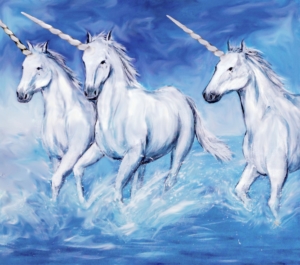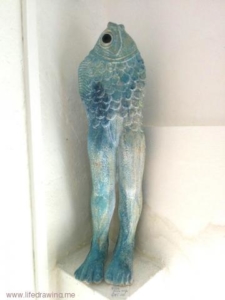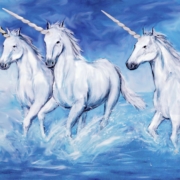Unicorn Bets Set in Race to Carbon Zero
Are capitalists hoping to harness unicorns to lead the charge to a zero carbon economy? Some experts think so and are calling for investment in unicorn incubation programmes with the promise of great returns. Recently the unicorn has lent its name to the elite group of billion dollar startup tech firms, and now looks set to sire a whole new breed of firms focused on facilitating low carbon living. As icecaps melt, sea levels rise, and global overheating threatens human extinction, can a magical horse with a pointed hat save the human race? Some hard-headed technologists are advocating this, so is it time we understood this beautiful beast and its future a bit better?
 The unicorn has captured the human imagination since the earliest days of India, appears in the Christian Bible, in medieval bestiary books illustrating beasts of every alleged kind, and has often been harnessed as a symbol. Typically understood to be a forest-dwelling white horse with a single, spiralling and pointed horn sticking out of its forehead, it might initially have been the ancients’ remote misinterpretation of actual one-horned animals such as the ibex or rhinoceros, or of profile representations of cattle, but it developed a mythical presence in the Middle Ages in Europe which lives on to this day.
The unicorn has captured the human imagination since the earliest days of India, appears in the Christian Bible, in medieval bestiary books illustrating beasts of every alleged kind, and has often been harnessed as a symbol. Typically understood to be a forest-dwelling white horse with a single, spiralling and pointed horn sticking out of its forehead, it might initially have been the ancients’ remote misinterpretation of actual one-horned animals such as the ibex or rhinoceros, or of profile representations of cattle, but it developed a mythical presence in the Middle Ages in Europe which lives on to this day.
 In medieval times and even into the Renaissance period the shy unicorn was seen as a symbol of purity, grace and even chastity, perhaps explaining its exceedingly low numbers. The material of its horn was thought to be able to purify poisoned water and heal sickness, and possibly act as an aphrodisiac, making it a very saleable commodity for those willing and able to pass off narwhal tusks as unicorn horn, much as in the present day diets and supplements are hawked which “remove toxins” or “chemicals” from food, water, and the human body. Nonetheless, there was an economic imperative for hunting unicorns, just as twenty-first century hunting of mighty rhinoceroses is driving them to extinction while people believe powder made from rhinoceros horn restores male potency. The imagined potency of such horned animals is such that they have even been used to advertise an exhibition at the British Museum containing a Volkswagen Beetle, with probably greater stimulating effect on visitor numbers than an illustration of a blue pill with a V on it would have.
In medieval times and even into the Renaissance period the shy unicorn was seen as a symbol of purity, grace and even chastity, perhaps explaining its exceedingly low numbers. The material of its horn was thought to be able to purify poisoned water and heal sickness, and possibly act as an aphrodisiac, making it a very saleable commodity for those willing and able to pass off narwhal tusks as unicorn horn, much as in the present day diets and supplements are hawked which “remove toxins” or “chemicals” from food, water, and the human body. Nonetheless, there was an economic imperative for hunting unicorns, just as twenty-first century hunting of mighty rhinoceroses is driving them to extinction while people believe powder made from rhinoceros horn restores male potency. The imagined potency of such horned animals is such that they have even been used to advertise an exhibition at the British Museum containing a Volkswagen Beetle, with probably greater stimulating effect on visitor numbers than an illustration of a blue pill with a V on it would have.
The recommended medieval method for capturing this valuable unicorn was to set a virgin human female in a forest as a lure, expecting a wild unicorn to go and gently lay its head in her lap. As there are no records of this succeeding, it is possible the bored trappers were themselves ensnared in ways which compromised the bait. The inability to locate unicorns gives rise to their role as symbols of rarity, or even signifiers of fantasy and unreality. Political debates about the United Kingdom leaving the European Union often featured references to unicorns, as no verifiable benefits of leaving were presented, aside from a vague belief that something magically better would appear, leading to advocates of leaving being characterised as “unicorn merchants”.
The relative rarity of billion dollar tech startups has led to them being called unicorns, but as they multiply and prosper, the term decacorn will be needed for the emerging ten billion dollar firms. The search for new technical solutions in industries which emit CO2 has led fossil fuel colossus BP to invest in technologies it hopes will become low carbon giants, luring them with cash rather than virgins despite BP’s record of despoiling nature. Others advocate the financing of a new form of unicorn for example, energy storage using hydrogen or ammonia, or water-efficient plants allowing agriculture in new locations:
A research group in Oxford … has been identifying groups of “unicorn” technologies, named by analogy with “unicorn” startups valued at over $1bn, that can each deliver a reduction of at least a billion tonnes of CO2 a year. Unicorns don’t depend on fundamental new discoveries so should be ready for large-scale deployment within a decade. With a moderate investment in research and development or other support, they could in combination unlock multiple benefits across whole “energy ecosystems”.

Ceramic mermaid by Michele Cowmeadow
The word unicorn originally derives from the Latin for “one horn”, with the German translation being Einhorn, or Onehorn. The unicorn should not be confused with other mythical creatures such as the Greeks’ Pegasus the winged horse, or Doctor Dolittle’s pushmi-pullyu, or Disney’s Dumbo the winged elephant, nor with the mermaid, a mythical fish which is half woman and lures unfortunate ships to the depths. Unicorns also feature in toys, may display fluid gender, and even have their own National Unicorn Day, which is on 9 April, not 29 February. If indeed unicorn technologies are able to stop global overheating and prevent climate breakdown, an age of plenty may begin which would be termed Unicornucopia, so perhaps the time has come for Unicornucopianism.




